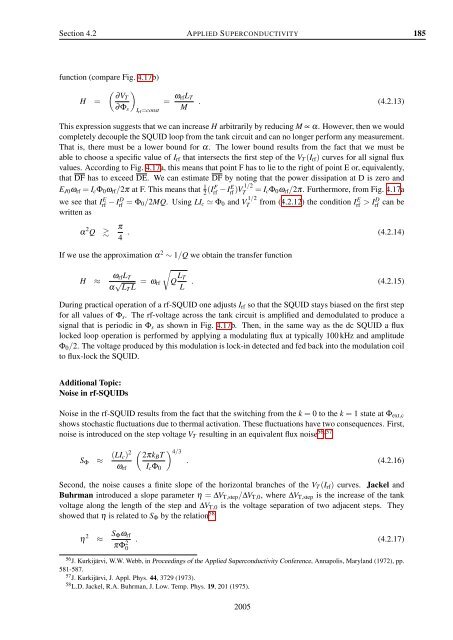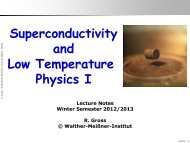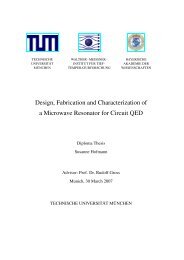Applied Superconductivity - Walther Meißner Institut - Bayerische ...
Applied Superconductivity - Walther Meißner Institut - Bayerische ...
Applied Superconductivity - Walther Meißner Institut - Bayerische ...
- No tags were found...
Create successful ePaper yourself
Turn your PDF publications into a flip-book with our unique Google optimized e-Paper software.
Section 4.2 APPLIED SUPERCONDUCTIVITY 185function (compare Fig. 4.17b)H =( ∂VT∂Φ s)I rf =const= ω rfL TM . (4.2.13)This expression suggests that we can increase H arbitrarily by reducing M ∝ α. However, then we wouldcompletely decouple the SQUID loop from the tank circuit and can no longer perform any measurement.That is, there must be a lower bound for α. The lower bound results from the fact that we must beable to choose a specific value of I rf that intersects the first step of the V T (I rf ) curves for all signal fluxvalues. According to Fig. 4.17a, this means that point F has to lie to the right of point E or, equivalently,that DF has to exceed DE. We can estimate DF by noting that the power dissipation at D is zero andE J0 ω rf = I c Φ 0 ω rf /2π at F. This means that 1 2 (IF rf − IE 1/2rf)VT = I c Φ 0 ω rf /2π. Furthermore, from Fig. 4.17awe see that Irf E − ID rf = Φ 0/2MQ. Using LI c ≃ Φ 0 and V 1/2T from (4.2.12) the condition Irf E > ID rfcan bewritten asα 2 Q π 4 . (4.2.14)If we use the approximation α 2 ∼ 1/Q we obtain the transfer function√H ≈ ω rfL Tα √ L T L = ω rf Q L TL . (4.2.15)During practical operation of a rf-SQUID one adjusts I rf so that the SQUID stays biased on the first stepfor all values of Φ s . The rf-voltage across the tank circuit is amplified and demodulated to produce asignal that is periodic in Φ s as shown in Fig. 4.17b. Then, in the same way as the dc SQUID a fluxlocked loop operation is performed by applying a modulating flux at typically 100 kHz and amplitudeΦ 0 /2. The voltage produced by this modulation is lock-in detected and fed back into the modulation coilto flux-lock the SQUID.Additional Topic:Noise in rf-SQUIDsNoise in the rf-SQUID results from the fact that the switching from the k = 0 to the k = 1 state at Φ ext,cshows stochastic fluctuations due to thermal activation. These fluctuations have two consequences. First,noise is introduced on the step voltage V T resulting in an equivalent flux noise 56,57S Φ ≈ (LI c) 2ω rf( 2πkB TI c Φ 0) 4/3. (4.2.16)Second, the noise causes a finite slope of the horizontal branches of the V T (I rf ) curves. Jackel andBuhrman introduced a slope parameter η = ∆V T,step /∆V T,0 , where ∆V T,step is the increase of the tankvoltage along the length of the step and ∆V T,0 is the voltage separation of two adjacent steps. Theyshowed that η is related to S Φ by the relation 58η 2 ≈ S Φω rfπΦ 2 0. (4.2.17)56 J. Kurkijärvi, W.W. Webb, in Proceedings of the <strong>Applied</strong> <strong>Superconductivity</strong> Conference, Annapolis, Maryland (1972), pp.581-587.57 J. Kurkijärvi, J. Appl. Phys. 44, 3729 (1973).58 L.D. Jackel, R.A. Buhrman, J. Low. Temp. Phys. 19, 201 (1975).2005
















